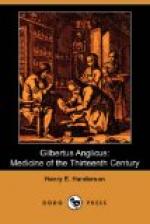Gilbert was undoubtedly one of the most famous physicians of his time. His reputation is recognized in those well-known lines of Chaucer which catalogue the “authorities” of his Doctor of Phisik:
“Wel knew he the olde Esculapius
And Deyscorides and eek Rufus,
Olde Ypocras, Haly and Galyen,
Serapion, Razis and Avycen,
Averrois, Damascien and Constantyn,
Bernard and Gatesden and Gilbertyn.”
He is also quoted with frequency and respect by the medical writers of many succeeding ages, and the Compendium, first printed in 1510, enjoyed the honor of a second edition as late as the seventeenth century (1608). The surname “Anglicus” in itself testifies to the European reputation of our author, for as Dr. Payne sensibly remarks, no one in England would speak of an English writer as “the Englishman.”
Yet, in spite of his reputation, we know almost no details of the life of Gilbert, and are forced to content ourselves with the few facts to be gleaned from the scanty biographies of early writers and the inferences drawn from the pages of the Compendium itself. The date and place of his birth and death, and even the field of his medical activities are equally unknown. Bale, Pits and Leland, the earliest English biographers, tell us that Gilbert, after the completion of his studies in England, proceeded to the Continent to enlarge his education, and finally became physician to the great Justiciar, Hubert Walter, archbishop of Canterbury, who died in the year 1205. This would place him under the reign of King John, in the early part of the thirteenth century.
Dr. John Freind, however, the famous English physician and medical historian (1725), observing that Gilbert quotes the Arabian philosopher Averroes (who died in 1198), and believing that he also quotes a work of Roger Bacon and the surgical writings of Theodorius (Borgognoni) of Cervia (1266), was inclined to fix his period in the latter half of the thirteenth century, probably under the reign of Edward I. Most of the later historians of medicine have followed the views of Freind. Thus Eloy adopts the date 1272, Sprengel gives 1290, Haeser the same date, Hirsch says Gilbert lived towards the close of the thirteenth century, Baas adopts the figures 1290, etc.
The most recent biographers of Gilbert, however, Mr. C.L. Kingsford[1], and the late Dr. Joseph Frank Payne[2], after an apparently careful and independent investigation of his life, have reached conclusions which vary materially from each other and from those of the historians mentioned. Mr. Kingsford fixes the date of Gilbert at about 1250, while Dr. Payne reverts to the views of Bale and Pits and suggests as approximate figures for the birth and death of Gilbert the years 1170-80 to 1230. This discrepancy of twenty-five or thirty years between the views of two competent and unprejudiced investigators, as a mere question of erudition and interpretation, is perhaps scarcely worthy of prolonged discussion. But as both biographers argue from substantially the same data, the arguments reveal so many interesting and pertinent facts, and the numerous difficulties attending the interpretation of these facts, that some comparison of the different views of the biographers and some criticism of their varying conclusions may not be unwelcome.




